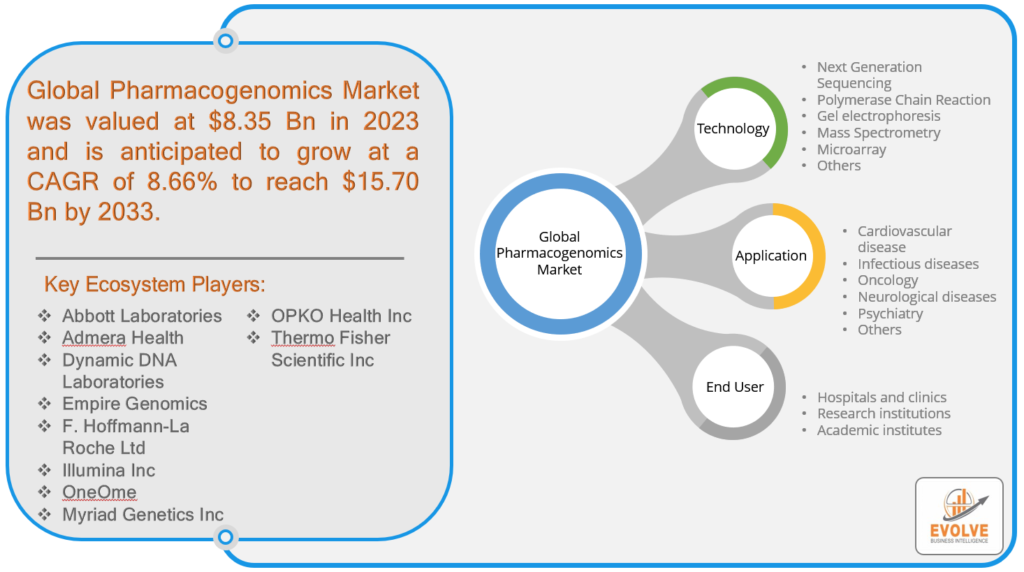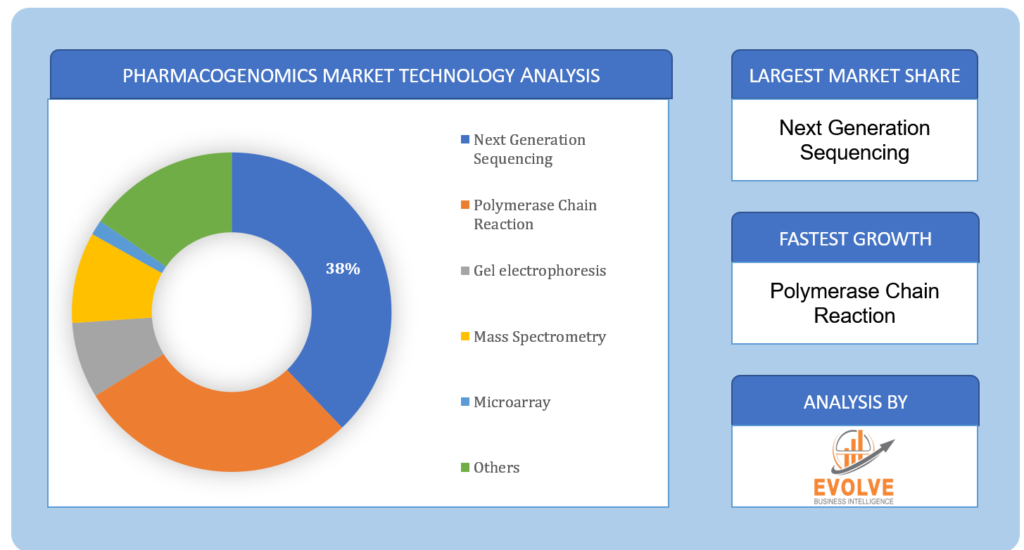Pharmacogenomics Market Analysis and Global Forecast 2023-2033
$1,390.00 – $5,520.00Price range: $1,390.00 through $5,520.00
Pharmacogenomics Market Research Report: Information By Technology (Next Generation Sequencing, Polymerase Chain Reaction, Gel Electrophoresis, Mass Spectrometry, Microarray, Others), By Application (Cardiovascular Disease, Infectious Diseases, Oncology, Neurological Diseases, Psychiatry, Others), By End User (Hospitals And Clinics, Research Institutions, Academic Institutes), and By Region — Forecast till 2033
[vc_row][vc_column width=”2/3″][vc_column_text woodmart_inline=”no” text_larger=”no”]Global Pharmacogenomics Market Size is expected to reach USD 15.70 Billion by 2033. The global Pharmacogenomics market size accounted for USD 8.35 billion in 2023 and is expected to expand at a compound annual growth rate (CAGR) of 8.66% from 2023 to 2033. Pharmacogenomics is a field of study that examines how a person’s genetic makeup influences their response to drugs. It combines pharmacology, which is the study of how drugs work in the body, with genomics, which is the study of an individual’s genes and their function. Pharmacogenomics seeks to understand how genetic variations can affect how a person metabolizes, responds to, and experiences the effects of medications. Pharmacogenomics takes into account an individual’s genetic information, such as their DNA sequence, genetic mutations, and gene expression patterns, to optimize drug therapy. It involves identifying genetic markers that are associated with drug response and using this information to guide drug selection, dosage adjustments, and treatment plans tailored to an individual’s genetic profile. By considering a person’s genetic makeup, pharmacogenomics aims to improve the safety and effectiveness of drug therapies, reduce adverse drug reactions, minimize trial-and-error approaches in drug prescribing, and ultimately achieve more personalized and precise medical care. Pharmacogenomics has applications in various areas of medicine, including oncology, psychiatry, cardiology, infectious diseases, and many other therapeutic areas. It is an interdisciplinary field that involves collaborations between researchers, clinicians, pharmacists, and other healthcare professionals, and the integration of genomic data into clinical decision-making processes. Pharmacogenomics holds the promise of advancing personalized medicine and transforming the way drugs are prescribed, administered, and monitored to optimize patient outcomes.
The COVID-19 pandemic had a mixed impact on the Pharmacogenomics market. While there has been increased focus on personalized medicine and remote healthcare services, disruptions in the supply chain, shifts in research focus, and impacts on clinical trials have also posed challenges for the industry. However, the long-term effects of the pandemic on the Pharmacogenomics market are still evolving, and the industry is likely to continue to adapt and innovate in response to the changing landscape.
Pharmacogenomics Market Dynamics
The major factors that have impacted the growth of Pharmacogenomics are as follows:
Drivers:
Increasing Demand for Precision Medicine
Precision medicine, which aims to deliver the right treatment to the right patient at the right time, has gained momentum in healthcare. Pharmacogenomics is a key component of precision medicine, as it enables healthcare providers to optimize drug selection and dosing based on an individual’s genetic profile, leading to more effective and safer treatments.
Growing Awareness of Adverse Drug Reactions
Adverse drug reactions (ADRs) are a significant burden on healthcare systems, leading to increased healthcare costs and patient morbidity and mortality. Pharmacogenomics can help identify genetic factors that predispose individuals to ADRs, allowing for proactive measures to mitigate the risk. As awareness of ADRs and the importance of personalized medicine grows, the demand for pharmacogenomics testing is expected to increase.
Restraint:
- Limited Clinical Evidence
Despite the growing body of research supporting the role of pharmacogenomics in guiding drug therapy, there is still limited clinical evidence demonstrating the cost-effectiveness and clinical utility of pharmacogenomics testing in routine clinical practice. The lack of robust evidence may hinder the widespread adoption of pharmacogenomics in some healthcare settings, as clinicians and payers may require more data to support its clinical and economic value.
Opportunity:
Growing Demand for Precision Medicine
Precision medicine, which involves the use of genetic information to guide medical decisions, is gaining traction globally. Pharmacogenomics is a key component of precision medicine, as it provides valuable genetic information that can guide drug selection, dosing, and monitoring. The increasing demand for precision medicine, driven by advancements in genetic testing technologies, growing awareness among healthcare providers and patients, and the need for more targeted and effective therapies, presents a significant opportunity for the pharmacogenomics market.
Pharmacogenomics Segment Overview
Based on the Technology, the market is segmented based on Next Generation Sequencing, Polymerase Chain Reaction, Gel electrophoresis, Mass Spectrometry, Microarray, and Others. During the projection period, the Next Generation Sequencing segment is expected to hold the largest market share. Next Generation Sequencing (NGS) is a powerful and widely used technology for analyzing genetic data, and it has revolutionized the field of Pharmacogenomics by enabling high-throughput sequencing of genes and other genomic regions to identify genetic variations that may influence drug response. The ability of NGS to provide comprehensive and high-resolution genetic information has made it a preferred method for Pharmacogenomics research and clinical applications.
By Application
Based on Application, the market has been divided into Cardiovascular Disease, Infectious Diseases, Oncology, Neurological Diseases, Psychiatry, and Others. The Cardiovascular Disease segment is expected to hold the largest market share. Cardiovascular Diseases (CVD) such as heart disease and stroke, are major global health concerns and a leading cause of morbidity and mortality worldwide. Pharmacogenomics has emerged as a promising approach for optimizing the management and treatment of CVDs by considering an individual’s genetic makeup in drug selection, dosing, and monitoring.
By End User
Based on End Users, the market has been divided into Hospitals and clinics, Research institutions, and Academic institutes. The Hospitals and clinics segment is expected to hold the largest market share. Hospitals and clinics are key settings where Pharmacogenomics can be applied in patient care. Many hospitals and clinics have started incorporating Pharmacogenomics testing into their clinical practice to aid in personalized medication management, optimize drug therapies, and minimize adverse drug reactions. Pharmacogenomics can be particularly relevant in specialty clinics, such as oncology or cardiology, where genetic testing can help guide treatment decisions and improve patient outcomes.
Global Pharmacogenomics Market Share, by Segmentation
 Global Pharmacogenomics Market Regional Analysis
Global Pharmacogenomics Market Regional Analysis
Based on region, the global pharmacogenomics market has been divided into North America, Europe, Asia-Pacific, and the Rest of the World. North America is projected to dominate the use of the market followed by the Asia-Pacific and Europe regions.
North America Market
North America is projected to dominate the pharmacogenomics market. The market for pharmacogenomics is influenced by various factors such as advancements in genomic research, increasing awareness about personalized medicine, and growing demand for precision therapies. North America has traditionally been a key player in the pharmaceutical and biotechnology industries and has a strong presence in the field of pharmacogenomics. The region has a well-established healthcare infrastructure, advanced research and development capabilities, and significant investments in genomics research. Additionally, the FDA (U.S. Food and Drug Administration) has been supportive of pharmacogenomics research and has provided regulatory guidance in this area, which has contributed to the growth of the pharmacogenomics market in North America.
Asia-Pacific Market
The Asia-Pacific region is projected to be a prominent growth market for Pharmacogenomics in the coming years. The Asia-Pacific region is known for its diverse population, which includes different ethnicities and genetic backgrounds. This genetic diversity can impact how individuals respond to drugs, making pharmacogenomics an important field for optimizing drug therapy in this region. As healthcare systems in the region continue to evolve and focus on precision medicine, the demand for pharmacogenomics is expected to increase. The Asia-Pacific region has seen significant advancements in genomics research in recent years, including large-scale genomic initiatives, research collaborations, and investments in genomic research infrastructure. These advancements are driving the development of pharmacogenomics research and applications in the region.
Competitive Landscape
The market comprises tier-1, tier-2, and local players. With their wide product portfolios, tier-1 and tier-2 players have a global reach. Since their strategic innovations and broad regional presence, companies such as Abbott Laboratories, Admera Health, Dynamic DNA Laboratories, Empire Genomics, and F. Hoffmann-La Roche Ltd lead the global Pharmacogenomics business. To increase their market position and attract a wide consumer base, the businesses are employing various strategies, such as growth, product releases, and alliances.
Prominent Players:
- Abbott Laboratories
- Admera Health
- Dynamic DNA Laboratories
- Empire Genomics
- Hoffmann-La Roche Ltd
- Illumina Inc
- OneOme
- Myriad Genetics Inc
- OPKO Health Inc
- Invitae
- Thermo Fisher Scientific Inc
Key Development:
May 2022: Invitae announced the release of the enhanced Invitae Pharmacogenomics (PGx) Panel, which provides access to a clinical decision support tool and the specialized Invitae Pharmacogenomics Mental Health Panel (CDST).
March 2022: Day-Lewis announced their intention to open a community pharmacy with a private pharmacogenomic testing service.
Scope of the Report
Global Pharmacogenomics Market, by Technology
- Next Generation Sequencing
- Polymerase Chain Reaction
- Gel electrophoresis
- Mass Spectrometry
- Microarray
- Others
Global Pharmacogenomics Market, by Application
- Cardiovascular disease
- Infectious diseases
- Oncology
- Neurological diseases
- Psychiatry
- Others
Global Pharmacogenomics Market, by End User
- Hospitals and clinics
- Research institutions
- Academic institutes
Global Pharmacogenomics Market, by Region
- North America
- US
- Canada
- Mexico
- Europe
- UK
- Germany
- France
- Italy
- Spain
- Benelux
- Nordic
- Rest of Europe
- Asia Pacific
- China
- Japan
- South Korea
- Indonesia
- Austalia
- Malaysia
- India
- Rest of Asia Pacific
- South America
- Brazil
- Argentina
- Rest of South America
- Middle East & Africa
- Saudi Arabia
- UAE
- Egypt
- South Africa
- Rest of Middle East & Africa
| Parameters | Indicators |
|---|---|
| Market Size | 2033: $15.70 Billion |
| CAGR | 8.66% CAGR (2023-2033) |
| Base year | 2022 |
| Forecast Period | 2023-2033 |
| Historical Data | 2021 |
| Report Coverage | Revenue Forecast, Competitive Landscape, Growth Factors, and Trends |
| Key Segmentations | Technology, Application, End User |
| Geographies Covered | North America, Europe, Asia-Pacific, Latin America, Middle East, Africa |
| Key Vendors | Abbott Laboratories, Admera Health, Dynamic DNA Laboratories, Empire Genomics, F. Hoffmann-La Roche Ltd, Illumina Inc, OneOme, Myriad Genetics Inc, OPKO Health Inc, Thermo Fisher Scientific Inc. |
| Key Market Opportunities | Growing Demand for Precision Medicine |
| Key Market Drivers | Increasing Demand for Precision Medicine Growing Awareness of Adverse Drug Reactions |
REPORT CONTENT BRIEF:
- High-level analysis of the current and future Pharmacogenomics market trends and opportunities
- Detailed analysis of current market drivers, restraining factors, and opportunities in the future
- Pharmacogenomics market historical market size for the year 2021, and forecast from 2023 to 2033
- Pharmacogenomics market share analysis at each product level
- Competitor analysis with a detailed insight into its product segment, financial strength, and strategies adopted.
- Identifies key strategies adopted including product launches and developments, mergers and acquisitions, joint ventures, collaborations, and partnerships as well as funding taken and investment done, among others.
- To identify and understand the various factors involved in the global Pharmacogenomics market affected by the pandemic
- To provide a detailed insight into the major companies operating in the market. The profiling will include the financial health of the company’s past 2-3 years with segmental and regional revenue breakup, product offering, recent developments, SWOT analysis, and key strategies.
[/vc_column_text][/vc_column][vc_column width=”1/3″][vc_column_text woodmart_inline=”no” text_larger=”no”][html_block id=”3961″][/vc_column_text][vc_wp_text]
Press Release
[rpwe limit=”10″ thumb=”true”][/vc_wp_text][/vc_column][/vc_row][vc_row][vc_column][vc_column_text woodmart_inline=”no” text_larger=”no”]
Frequently Asked Questions (FAQ)
[sp_easyaccordion id=”12664″][/vc_column_text][/vc_column][/vc_row]





